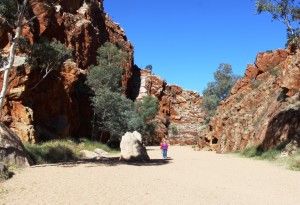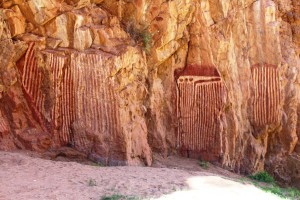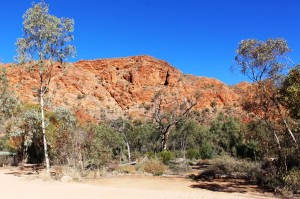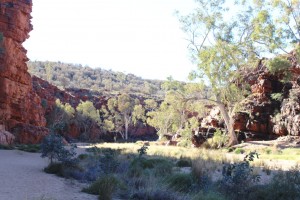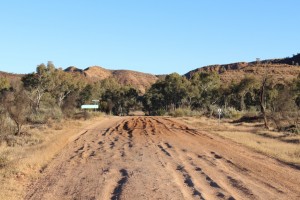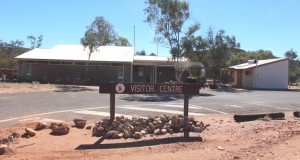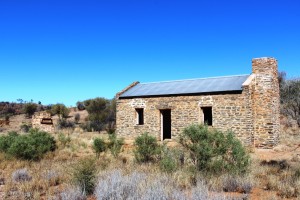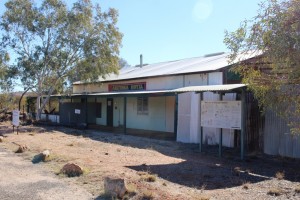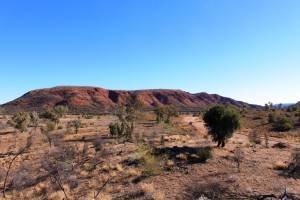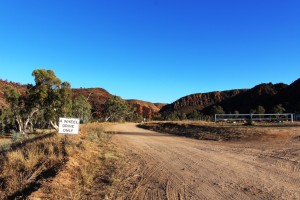Our plan had been to take the van into the East and West MacDonnell Ranges and spend nights in various National Park camping facilities. But on our first morning in Alice Springs I woke with cold feet, so checked the Weather Channel’s app to find that the temperature was zero, but felt like – 3. The forecast made it clear that there would be no improvement over the next week or so. So the imperative become to find somewhere with electricity.
Fortunately, both areas have bush resorts with caravan parks attached that have powered sites available. So the new plan is fixed. The Ross River Resort for two nights, then Glen Helen Gorge Resort for two more and then back into Alice Springs for a final two nights.
We have covered this area before, but had missed some attractions through rain that had derailed our plans. There is, however, nothing wrong with a revisit or two. So for a start we revised Emily and Jessie Gaps. One of the unique features of the MacDonnell Ranges are the gaps that cut through them. These gaps take the form of creeks that carry water from the higher ground on the north side of the range to the lower south side and ultimately to the desert. Both flow into the better known Todd River.
When we were here four years ago Jessie Gap was full of water but this year both are dry, as is Trephina Gorge, which was to have been our base in the area, until the cold weather sent us looking for electricity. As an alternative, we had planned to have lunch there, but the road in was quite rough so we decided to put the van on site at Ross River and return later in the day.
Trephina Gorge is worth a visit at any time. Trephina Creek runs a twisted course between rust red rock cliffs under the watchful eye of precipitous rust red mountains, including Trephina Bluff that provides a backdrop for campers. The mountains are decorated with green vegetation which includes white boughed ghost gums that really stand out against the vivid red of the rocks.
Four years ago Trephina Creek was flowing, but this time it is completely dry. But the lack of water allowed us to walk further along the creek bed and gain a much better understanding of the area above the gorge.
Ross River Resort is like Gemtree Caravan Park, in that it is situated on a sealed highway part of which becomes a link between two parts of the very unsealed Binns Track. In both cases a section of the Binns Track ends at the highway and it is necessary to travel a short distance on the highway to reach the next part of the Track.
Ross River Resort is an older bush establishment sighted around the original station homestead with basic accommodation in older style cabins. About one kilometer away, on the opposite side of the Binns Track the very spacious camp ground is almost tucked in between two mountain ranges. Facilities are basic but clean and everyone is friendly.
In addition to places already mentioned we had on our list the N’Dhalia Gorge which is only a few km down the Binns Track from Ross River and the Arltunga Historical Reserve, about 40 km to the north. N’Dhalia Gorge was scratched when I baulked at a water crossing where the track crosses the Ross River just near the camp ground. I am not confident with water crossings and found later that this one was OK, but by that time it was too late in the day. Arltunga was a different matter.
The old gold town of Arltunga was the first European settlement in Central Australia. Explorers found what they thought were rubies so a ruby rush started. But the gems were almost worthless garnets. Two of the disappointed miners decided to look for other minerals and found gold. South Australia now had its very own gold rush. South Australia had responsibility
for Northern Territory at that time. The gold find and subsequent development of the town of Arltunga lead to the SA government deciding to commit to Central Australia. They established the town of Stuart the name of which was later changed to Alice Springs.
Arltunga was 800 km from the rail head at Oodnadatta. Miners had to find their own way along the route of the overland telegraph line to
Alice Springs and then travel through the East MacDonnell Ranges to Arltunga, a further 100 km or so, often pushing their meager belongings in a wheelbarrow.
Because the area is so isolated, when the gold ran out the residents simply left and the process of deterioration commenced. Nothing was built in its place. Buildings were constructed from the stone of the surrounding countryside so have been easy to rebuild. There is an information center that does an excellent job of telling the story and also supplies excellent maps and other material.
Buildings have been restored at the site of the government ore processing battery while the police station and lockup look ready for the return of officers and miscreants. Gold mining was both alluvial and underground. Two underground mines are available for inspection by those who remember to bring a torch.
The drive from Ross River to Arltunga is superb. The road goes through a pass that follows the course of the dry Bitter Springs Creek and then runs along adjacent to the northern face of a most picturesque red mountain range. Turning northeast it parallels another range of a different hue, crosses a plain and reaches Arltunga at the foot of the next range of hills. The gravel road varies from a few areas of vehicle destroying corrugations to smooth surfaces, but most of the way it was like most gravel roads – light corrugations that can comfortably be taken at 60 mph.
The East MacDonnell Ranges tend to be overshadowed by their Western counterparts, probably because the latter have more marketable features that attract the “been there done that” and the “bucket list” people. But I am more an ambiance person. I like just being in the East MacDonnell Ranges, because of the atmosphere that results from the colour, form and variety of scenery that makes the place so unique.

